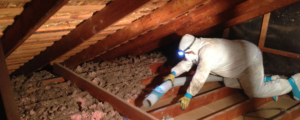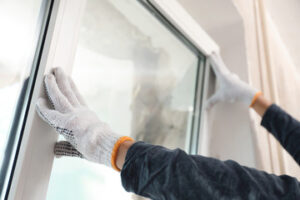Insulation is a vital part of a home. It is often overlooked but can be a major factor in your home’s comfort and energy efficiency.
Many people find themselves removing their old insulation due to rodent damage, a renovation, or moving into a new home. Removing the old insulation is relatively simple, but it can be messy and requires some safety precautions. Click https://perthinsulationremover.com.au/ to learn more.

If you’re having an attic space insulated with spray foam, it is important to remove any old fiberglass or cellulose insulation from the attic floor. This prevents air from blowing past the new insulation and reduces energy costs and makes the new insulation work even better. Removing the older insulation also helps keep your home cleaner and safer.
Before starting the process of removing your old insulation, it is recommended to wear personal protective gear (gloves, goggles, long sleeves, and a mask). Insulation contains airborne materials that can affect your health. If you are not comfortable performing this task, contact a professional insulation removal team.
The best tool to use for removing your old insulation is an insulation removal vacuum cleaner, which is typically gas-powered and uses a high-capacity HEPA filter. It will help you remove the old insulation faster and will stir up less potentially toxic dust into the air, which can contaminate your living spaces. The Vaccum will also make it much easier to clean up afterward, as the insulation will be all contained in one bag.
You can rent these machines from many hardware stores, but you can also purchase them. Some even come with their own trailers for easy transportation.
Once you’ve gathered your equipment and assembled the necessary tools, it is time to start working. Start by clearing a path to your attic access and covering the walls and floors with a large plastic sheet or tarp. This will catch any loose pieces of insulation and keep them from landing in your living space, causing drywall damage.
If you’re using a ladder to get into the attic, it is a good idea to place it against a wall and cover the area underneath it with a plastic sheet. This will ensure that no pieces of insulation fall down on you as you climb up and down the ladder.
Next, clear the attic floor of all debris and dispose of it properly. You can contact your local waste management facility to ask about specific guidelines on disposing of cellulose and fiberglass insulation materials.
Over time, insulation – even in batt form – begins to decompose and may contain mold or mildew. This is bad for your air quality, but it can also be a major mess that’s difficult and time-consuming to clean up. Ideally, the best thing to do is work with professionals to remove old insulation from your attic and your home. These companies are able to quickly and efficiently do the job, protecting you from dangerous particulate matter that could end up in your home’s central air system.
While they’re working, they can also vacuum up any debris that’s created as the insulation is removed. This can help prevent the particulate matter from entering your living space and causing health problems in your family. It can also be a much easier process than trying to do it yourself without the proper equipment and protection.
If you choose to go the DIY route, make sure you have a shop vac and a lot of large plastic bags to use for the cleanup. It’s also a good idea to spread plastic or a drop cloth over any furniture in the area where you’re doing the work. This will help prevent messes that are going to be difficult and expensive to clean up.
Even with a vacuum, it can be a messy job. Cellulose insulation, which is typically made out of recycled newspaper, can create a huge amount of dust that will easily get into the rest of your house. That’s why it’s important to wear a dust mask and safety glasses while you’re doing the job.
You’ll also want to have a couple of large garbage bins or trash bags to put the contaminated insulation into once you’re done. That way, you can dispose of it safely without exposing yourself to the potential hazards that might be in some of the older forms of insulation, like asbestos or vermiculite. This is a good reason why it’s a good idea to have professionals test the old insulation before attempting to remove it, especially if you think it might be old fiberglass or vermiculite.
When you are reinsulating your home, it is important to consider the proper disposal of old insulation. Disposal methods can vary depending on the type of insulation you have and your local regulations. For example, fiberglass insulation is often recycled to make new material. However, cellulose and other types of loose-fill insulation are not recyclable and must be taken to the landfill. The good news is that landfills are better equipped to handle waste material and have regulations in place to minimize environmental contamination and other concerns.
For loose-fill insulation, it is best to contain it within durable bags before you begin the removal process. This will help prevent the material from leaking out and spreading around your attic and living space. For this reason, it is a good idea to use a large, heavy-duty trash bag for the purpose. It is also a good idea to double-bag the material for added security and safety.
If you are using a blower to remove insulation, it is recommended that you seal off the area around the area from which you are working with plastic and/or a drop cloth. This will prevent the loose insulation from blowing away during the removal process. It is also a good idea to wear protective gloves and face masks when handling the insulation, as the fibers can be harmful to your health.
If you are unsure how to dispose of your insulation, it is always a good idea to consult a professional. These professionals are trained to safely and efficiently remove and dispose of the material while ensuring that no harm comes to the surrounding environment. They will have the necessary equipment to speed the entire process and will be familiar with local regulations regarding safe disposal. As such, hiring a professional can significantly reduce your stress and ensure that the job is done correctly.
Many homes built in older times are not insulated to modern standards and need more than the existing insulation. Adding new insulation can significantly cut energy costs and help make the house more comfortable year round. The cost of installing the right amount of insulation will depend on the type of insulation needed and the size of the house.
The most common form of home insulation is fiberglass, made from glass fibers. It is usually installed in the attic and the crawl space of a home. It is also commonly placed in the walls of a house and in ductwork. The type of fiberglass used varies and it is rated by its R value, with higher numbers denoting better resistance to heat flow.
It is possible to add insulation to a home without removing the existing drywall. Injection foam or blown-in cellulose can be used to fill wall cavities. These types of products offer advantages over loose-fill, batt or roll fiberglass as they resist mold and mildew growth better than the old fashioned insulation.
The first step to installing insulation in an older home is to do a thorough inspection of the attic and crawl space. If there is an extensive amount of debris in the attic or a lot of moisture in the crawl space, it may be necessary to remove the entire insulation and replace it with something more suitable. This should only be done by a professional who has the proper safety equipment.
Old insulation that is being removed can contain a number of dangerous materials including mold, animal feces and asbestos. It is vital that these materials are not allowed to contaminate the rest of the house during removal and should only be handled by professionals who have the necessary equipment.
The best time to add insulation to a home is during construction, when the walls and ceilings are still “open”. This makes it much easier to install drywall and then add insulation later on. However, insulating an existing home is not impossible, and it is worth the extra expense of hiring a professional to do the job.

